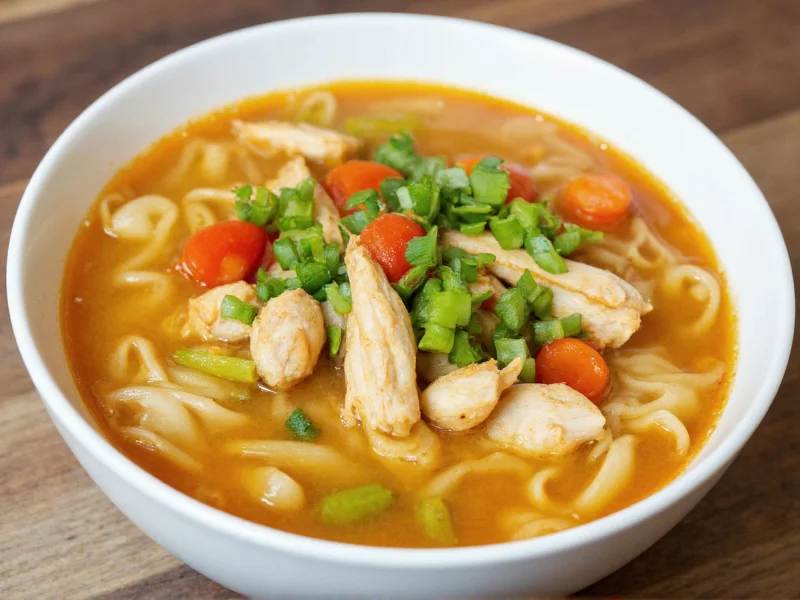Creating an exceptional homemade chicken noodle vegetable soup requires understanding the balance between rich broth, perfectly cooked noodles, and vibrant vegetables. This timeless recipe has sustained generations through cold seasons and recovery periods, earning its reputation as both nourishment and comfort. The magic happens when quality ingredients combine through proper technique to create a broth that's golden, flavorful, and deeply satisfying.
The Essential Chicken Noodle Vegetable Soup Recipe
For a traditional preparation of healthy chicken noodle soup with vegetables, gather these ingredients:
| Ingredient | Quantity | Preparation Notes |
|---|---|---|
| Chicken thighs or breast | 1.5 lbs | Bone-in for richer broth |
| Carrots | 3 medium | Peeled and sliced 1/4 inch thick |
| Celery stalks | 3 | Sliced thinly on diagonal |
| Yellow onion | 1 medium | Diced finely |
| Egg noodles | 8 oz | Wide or extra wide preferred |
| Garlic cloves | 3 | Minced |
| Fresh parsley | 3 tbsp | Chopped |
| Thyme | 1 tsp | Dried or 3 sprigs fresh |
| Bay leaves | 2 | Removed before serving |
| Chicken broth | 6 cups | Low sodium preferred |
Step-by-Step Preparation
Follow these instructions for how to make chicken noodle soup from scratch that avoids common pitfalls like mushy noodles or bland broth:
- Build the foundation: In a large pot, combine chicken, broth, onion, celery, carrots, garlic, thyme, and bay leaves. Bring to a gentle simmer over medium heat.
- Simmer for depth: Partially cover and simmer for 45 minutes. This slow extraction creates complex flavors without clouding the broth.
- Remove and shred chicken: Transfer chicken to cutting board, cool slightly, then shred with two forks. Return meat to pot after removing bones.
- Cook noodles separately: Prepare egg noodles according to package directions in separate pot. Drain and rinse with cold water to stop cooking. This prevents the common issue of soggy noodles in chicken noodle soup storage.
- Combine and finish: Add cooked noodles and parsley to broth mixture. Heat through without boiling to maintain noodle texture. Season with salt and pepper to taste.
Nutritional Benefits of Chicken Noodle Vegetable Soup
This classic preparation offers significant health advantages that explain why chicken noodle soup with extra vegetables remains a go-to remedy. A single 1.5 cup serving typically contains:
- Approximately 250 calories
- 18g protein for tissue repair
- Essential vitamins A and C from vegetables
- Hydrating properties from broth
- Natural anti-inflammatory compounds
Research indicates the steam from hot soup helps clear nasal passages, while the combination of nutrients supports immune function. The broth's electrolytes aid hydration during illness, making this recipe particularly valuable as chicken noodle vegetable soup for colds.
Variations for Dietary Needs
Adapt this base recipe for specific dietary requirements without sacrificing flavor:
Gluten-Free Chicken Noodle Vegetable Soup
Substitute traditional egg noodles with rice noodles, quinoa pasta, or spiralized vegetables like zucchini. Cook these alternatives separately and add at the end to prevent disintegration. For best results with gluten-free chicken noodle vegetable soup, use a high-quality gluten-free pasta that holds its shape during reheating.
Vegan Adaptation
Replace chicken with mushrooms and white beans for protein. Use vegetable broth instead of chicken broth, and add a tablespoon of nutritional yeast for umami depth. Include extra root vegetables like parsnips for heartiness.
Professional Cooking Tips
Master the art of easy chicken noodle soup recipe for beginners with these chef-recommended techniques:
- Broth clarity: Never boil the broth vigorously. A gentle simmer keeps the liquid clear and prevents fat emulsification.
- Noodle perfection: Cook noodles separately and add just before serving. This addresses the most frequent complaint in chicken noodle soup storage and reheating.
- Flavor layering: Sauté vegetables in olive oil before adding to broth for enhanced sweetness and depth.
- Acid balance: Finish with a squeeze of fresh lemon juice to brighten flavors that may have mellowed during cooking.
- Make-ahead strategy: Prepare broth and vegetables in advance, but add noodles only when serving to maintain optimal texture.
Storage and Reheating Guidelines
Proper chicken noodle soup storage and reheating techniques preserve quality:
- Store components separately: broth/vegetables in one container, cooked noodles in another
- Refrigerate for up to 4 days or freeze broth base for 3 months
- When reheating, bring broth to simmer first, then add noodles
- Avoid microwaving entire portions as it creates uneven heating and mushy noodles
- Add fresh herbs after reheating to restore brightness











 浙公网安备
33010002000092号
浙公网安备
33010002000092号 浙B2-20120091-4
浙B2-20120091-4